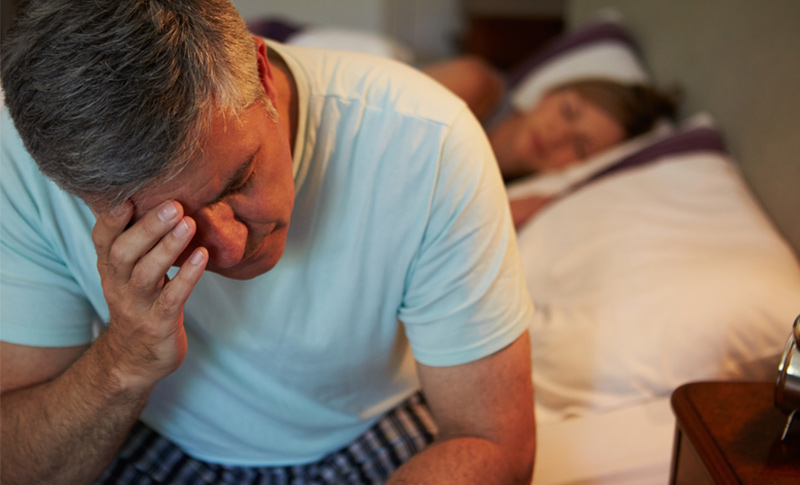
People who work at desk jobs try to remind themselves to get up regularly and stretch, since research has shown it is better for their general health. Those suffering from Restless Legs Syndrome, however, wish they had the choice of sitting still for as long as they wished, rather than being compelled to move.
What is Restless Leg Syndrome?
Restless Leg Syndrome (RLS) is a disorder that causes an uncontrollable urge to move your legs, generally because of discomfort. Between five and 15 per cent of Canadians suffer from RLS and describe the discomfort as a pins and needles sensation under the skin, tingling, crawling or prickling.
It is also called Willis-Ekbom Disease after two physicians, centuries apart, who described the disorder: Sir Thomas Willis, a 17th-century British physician, and Karl-Axel Ekbom, a Swedish physician writing in the 1940s.
Restless Legs Syndrome can begin at any time of life and usually worsens with age. It generally makes itself felt in the evenings and can interfere with sleep. About 80 per cent of people who suffer from RLS experience a related condition, periodic limb movements, twitches and kicks that happen at while you sleep.

Movement provides temporary relief to RLS sufferers, so travel can be difficult, because sitting in a confined space for long periods of time is uncomfortable.
What Causes Restless Leg Syndrome?
Although researchers are still exploring the cause for RLS, it may result from an imbalance of the chemical, dopamine, in the brain, because its messages help control muscle movement.
Often, Restless Leg Syndrome is hereditary, especially cases that begin before age 50. It may appear during pregnancy, especially in the last trimester, but RLS usually disappears after delivery.
Low levels of iron may bring on RLS, but it usually disappears with treatment. It is also often associated with diabetes and Parkinson’s disease.
Diagnosing the Disease
There is no test to diagnose RLS. The Mayo Clinic notes that a diagnosis is based on the following criteria, established by the International Restless Legs Syndrome Study Group:
- You have an often irresistible urge to move your legs, usually accompanied by uncomfortable sensations typically described as crawling, creeping, cramping, tingling or pulling.
- Your symptoms worsen during periods of inactivity, such as sitting or lying down.
- Your symptoms are partially or temporarily relieved by activity, such as walking or stretching.
- Your symptoms are worse at night.
- Your symptoms can’t be explained solely by another medical or behavioral condition.
Your physician may order other tests, such as a blood test to check iron levels or a test for nerve damage, in order to rule out other potential causes for your discomfort. You may also undergo a sleep study to determine whether you are afflicted by periodic limb movements.
Restless Leg Syndrome Treatment

You may be able to control Restless Leg Syndrome with lifestyle changes. Try the following suggestions for relief of symptoms:
- Get regular exercise. Your physiotherapist can devise an exercise therapy that will help alleviate symptoms. Avoid working out too late in the day, however, or the symptoms may intensify.
- Warm and cozy. Soak in a warm bath and massage your legs to relax the muscles. A physiotherapist can offer a massage that provides relief.
- Cut the coffee. Sometimes, avoiding caffeine alleviates symptoms, so try staying away from chocolate, coffee, tea and soft drinks for a few weeks and see if there is any improvement.
- Say om. Try relaxation techniques such as yoga or meditation. Stress aggravates RLS, so the more relaxed you are, the better.
- Sleep smartly. Fatigue worsens RLS. Develop good sleep habits. Make sure your bedroom is cool, quiet and dark. Go to bed and arise at the same time daily, whether or not it is a workday. These routines should allow for good sleep.
If non-medical remedies don’t make a difference in your discomfort, your physician may recommend medication. However, there is no perfect solution, since each of the available medications comes with its own caveats and/or side effects, including increased drowsiness and susceptibility to falling down.
RLS treatment is highly individual – there is no “one size fits all.” With the help of medical professionals, including physicians and physiotherapists, you should be able to create a relief program that works best for you.
[divider style=”empty” margin_top=”40px” margin_bottom=”0px”]
Experiencing symptoms of Restless Legs Syndrome?
Our experienced physiotherapists are here to help you.
[button size=”large” color=”orange” link=”https://southvanphysio.janeapp.com/”]Book Appointment Now[/button]
[divider style=”empty” margin_top=”60px” margin_bottom=”0px”]
